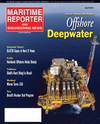
Page 37: of Maritime Reporter Magazine (April 2, 2010)
Read this page in Pdf, Flash or Html5 edition of April 2, 2010 Maritime Reporter Magazine
April 2010 www.marinelink.com 37 a traditional supplier of high quality naval products and have guaranteed through contractual clauses to transfer technology related to submarine construction and submarine systems, including the funda- mental sonar and weapons systems to the
Brazilian Navy.
DCNS Chairman & CEO Patrick
Boissier said on September 3, 2009: “We are proud that Brazil’s highest authorities have chosen DCNS to modernize and renew their country’s submarine fleet. I am aware of the responsibilities that this entails and have no doubt that each
DCNS team will do its share to ensure the complete success of this ambitious project. The contracts signed today con- firm our technological standing on the world market and the wisdom of our in- ternational strategy focusing on engi- neering services, new construction work, and the operation and maintenance of de- fense facilities.” This is the biggest con- tract in the history of DCNS.
Some characteristics of the Scorpene submarine project deserve special atten- tion. Although it is a diesel or conven- tional submarine, its project is not as a simple evolution of a previous diesel sub- marine class. Its hydrodynamic hull was derived from the Rubis class nuclear sub- marine, although more compact and it contains technological advances used in
French nuclear submarines, such as the
SUBTICS tactical integrated combat sys- tem, which combines operational effi- ciency, high-performance sensors and long-range weapons.
The sea trials of SUBTICS systems al- ready commissioned have demonstrated its level of performance and integration, including the capability to launch several types of weapons. Since modern sub- marines are increasingly used for both blue water and coastal missions ranging from anti-submarine or anti-surface war- fare to intelligence gathering, land attack and special operations, SUBTICS is de- signed for all these scenarios. The sys- tem´s key features include: • Outstanding sonars and other sensors, including, adaptive planar flank arrays for long-range detection, even at high speed; • Fusion of data, from all sensors (opti- cal, optronic, R-ESM and C-ESM, radar), location and identification of vessels; • Advanced, sea proven automatic and interactive target motion analysis; • Track association and fusion through interactive track management; • Aids for tactical analysis, decision- making and action management with re- spect to geographical and tactical environment; • Exchange of tactical data via datalinks; • Engagement of targets and control of different weapons; and • Anti-torpedo countermeasures system, named CONTRALTO-S, also deserves special attention. The CONTRALTO-S system – a new-generation solution – is designed to provide submarines with ef- fective protection against light- and heavyweight torpedoes. It is a system fully integrated in the combat manage- ment system (CMS) that proposes an eva- sive maneuver to the carrier and triggers the launch of CANTO munitions.
CANTO is a wide-spectrum jammer in-
Old Brazilian sub fleet with Sugar Loaf in the background. (Photo cr edit Marinha do Brasil)

 36
36

 38
38
